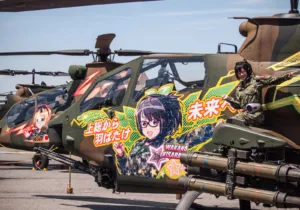President Donald Trump recently took to Twitter to announce that “If China decides to help [with North Korea] that would be great. If not, we will solve the problem without them.” Reports then emerged suggesting that the Carl Vinson carrier strike group was heading to the region. Noting that the “era of strategic patience is over,” Vice President Mike Pence added, “All options are on the table.” The message: The Trump administration is bracing for the worst. Setting aside the problems with conducting foreign policy by tweet, there are legitimate reasons to brace for the worst on the Korean Peninsula. The challenge in bracing for the worst is to not hasten the worst.
Before getting into what the worst might look like, let’s consider Pyongyang’s provocations.
Pyongyang’s war of words includes threats to turn South Korea (ROK) into “a sea of fire,” declarations that the 1953 armistice is “completely nullified,” and threats to conduct a “preemptive nuclear strike of justice” against the South.
Pyongyang underlines its warlike words with warlike actions—and outright acts of war: In 2010, North Korea shelled a South Korean island (killing four South Koreans) and torpedoed an ROK warship in South Korean waters (killing 46 ROK sailors). In 2012, North Korea conducted long-range missile tests under the guise of satellite launches. In 2013, Kim Jong-Un detonated a nuclear bomb and threatened nuclear strikes against the U.S. and ROK. In 2016, Pyongyang detonated two nuclear devices and conducted 21 missile tests, including tests of submarine-launched missiles. This year, Pyongyang has tested intermediate-range missiles and road-mobile missiles. “They are testing, and they are testing often,” satellite-imagery analyst Joseph Bermudez tells the Washington Post. “This is the way you really learn how to develop a ballistic missile, and that’s what worries me.”
Then there’s Pyongyang’s brutal treatment of its people. North Korea is guilty of “a wide array of crimes against humanity,” a UN panel concludes: “extermination, murder, enslavement, torture, imprisonment…persecution on political, religious, racial and gender grounds.”
In short, if there ever was a candidate for military intervention on humanitarian grounds—or preemptive military action on national-security grounds—it’s North Korea. However, any sort of military action against North Korea would trigger Korean War II. The toll from Korean War I should give us pause: 38,000 Americans, 103,000 South Koreans, 316,000 North Koreans, 422,000 Chinese, and some 2 million civilians killed during three years of conventional warfare. Today, we have the specter of a mushroom cloud hanging over the sequel.
The North deploys 4,100 tanks, 730 combat aircraft, and hundreds of missiles, some capable of striking Japan and Guam, perhaps Alaska and Hawaii. Kim’s arsenal includes 13,600 artillery pieces/rocket-launch systems. U.S.-ROK commanders expect every third round fired by North Korea to be a chemical weapon.
Korean War II would directly impact four of the largest economies on earth—South Korea, Japan, China, and the U.S.—representing almost 50 percent of global GDP. To be sure, it would end the Kim Dynasty, but it would give new meaning to “Pyrrhic victory.”
All of this explains why U.S. presidents have eschewed plans for “counterproliferation” via preemptive military action—and why the measure of success in Korea for U.S. presidents is simply getting through another day, another year, another term without another war. It’s a low bar. But given what Korean War II would look like, it’s a worthy goal. If patience allows North Korea to collapse like a rotten tree rather than explode like a time bomb, it is indeed a virtue. To be sure, that’s a big “if.”
So what steps can be taken?
Strengthen the Shield
Pentagon officials persuaded Seoul in 2016 to allow deployment of a THAAD anti-missile system, which the U.S. began erecting this March. This adds a layer of protection to the South, which already fields other missile-defense assets.
Last year, South Korea joined the U.S. and Japan for the trio’s first joint missile-defense exercises. Further integrating and networking these missile-defense systems—and deploying additional missile-defense assets—will help shield Americans, Japanese, and South Koreans from North Korean miscalculation or provocation. The next time a North Korean missile veers beyond North Korean airspace, the allies should demonstrate their seriousness by knocking it down. Tokyo appears poised to do that.
Pressure China
There are signs Beijing might rein in North Korea: cuts in coal shipments and air travel. But unless Trump can convince Beijing the status quo is unacceptable and unsustainable, Beijing will likely revert to its old ways because North Korea is a bigger headache for Washington than it is for Beijing. That hamstrings the U.S., and that’s in China’s interest. As President George W. Bush explained, when he tried to enlist Jiang Zemin’s help with Pyongyang, the Chinese leader “told me North Korea was my problem, not his.”
To keep China’s attention, a growing number of experts propose redeploying U.S. nuclear assets to South Korea (they were withdrawn in 1991) and/or greenlighting Seoul to deploy its own nuclear deterrent. (See here, here, here, here, here and here.) But like any gamble, there are risks to playing the nuclear card.
Rebuild the Arsenal
The only thing that has prevented Korean War II is America’s presence and deterrent strength. Yet in a time of war and widening international instability, U.S. defense spending has fallen from 4.6 percent of GDP in 2009 to 3.1 percent. This is the surest way to invite the worst of possibilities: what Churchill called “temptations to a trial of strength.” And here we are—in North Korea, the South China Sea, and Eastern Europe. The Trump administration has begun to reverse this downward spiral. But the bipartisan gamble known as sequestration has limited the military’s reach and resources, thus weakening America’s ability to deter war. Indeed, the administration’s apparent sleight-of-hand with the Carl Vinson—trying to make one carrier do the work of two or three—is an indication that the U.S. doesn’t have the carrier firepower it once had and still needs to coerce foes, reassure allies, and stabilize hotspots.
Discussing military spending and nuclear deterrence in the context of Christianity may seem incongruent to some. But it is not incongruent if we view military deterrence as a means to prevent the kind of war that would be fought on the Korean Peninsula. We will not know the biblical notion of peace until Christ returns to make all things new. In the interim, the alternatives to peace through strength—peace through crossing our fingers and peace through submission—are unacceptable for South Koreans, Japanese, Americans, and all people of goodwill.
—
Alan Dowd is a contributing editor to Providence and a senior fellow with the Sagamore Institute Center for America’s Purpose.
Photo Credit: North Korea “Day of Victory in the Great Fatherland Liberation War” Parade in July 2013. Pyongyang. By Stefan Krasowski, via Flickr.






